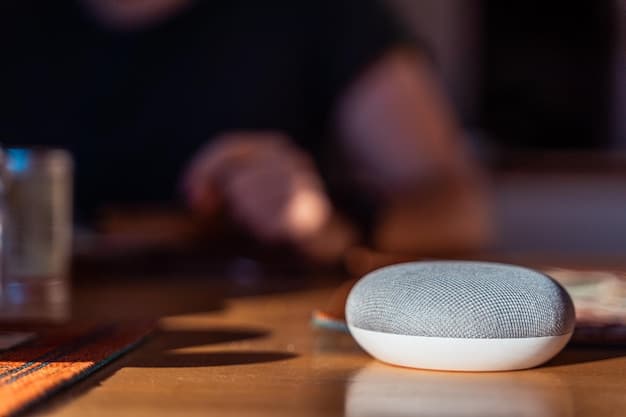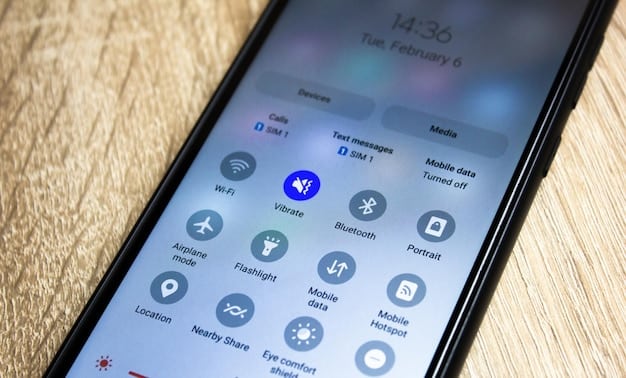Secure Your Privacy: A Guide to Smart Assistants and Voice Commands

Securing your privacy while using smart assistants and voice commands involves understanding the data collection practices of these devices, adjusting privacy settings, and employing strategies such as regularly reviewing voice history and being mindful of the commands spoken near them.
Navigating the world of smart assistants can feel like walking a tightrope between convenience and privacy. While these devices offer incredible ease-of-use through voice commands, it’s crucial to understand how to secure your privacy while using smart assistants and voice commands. This guide offers practical steps to protect your personal information while still enjoying the benefits of your favorite smart devices.
Understanding the Privacy Risks of Smart Assistants
Smart assistants, such as Amazon Echo (Alexa), Google Home, and Apple HomePod, have become integral parts of our homes. They offer a hands-free way to manage tasks, get information, and control other smart devices. However, their always-on nature raises significant privacy concerns. Let’s delve into the potential risks associated with their usage.
Data Collection Practices
Smart assistants collect a wealth of data, including your voice commands, device usage patterns, and even location data. This information is used to personalize your experience, improve the accuracy of voice recognition, and provide targeted advertising.
Potential for Unauthorized Access
While smart assistant manufacturers implement security measures to protect user data, vulnerabilities can still exist. Hackers may exploit these vulnerabilities to gain unauthorized access to your device and potentially eavesdrop on your conversations or access your personal information.

These risks highlight the importance of taking proactive steps to protect your privacy while using these devices. Next, we’ll explore practical strategies to minimize these risks and enhance your data security.
Adjusting Your Smart Assistant’s Privacy Settings
One of the most effective ways to manage your privacy with smart assistants is to adjust their privacy settings. Almost all of them offer various options to control data collection and usage. Take some time to familiarize yourself with these settings and customize them to your comfort level.
Reviewing Default Settings
Start by reviewing the default privacy settings of your smart assistant. Often, these settings are configured to collect as much data as possible. Understand what each setting controls and adjust it accordingly.
Disabling Data Collection
Consider disabling features that collect data you’re uncomfortable sharing. For example, you might disable the recording of voice commands or limit the collection of location data. This can significantly reduce the amount of personal information collected by the device.
- Regularly check and update your privacy settings.
- Be aware of the data collection practices for each smart assistant.
- Opt-out of personalized advertising and data sharing with third parties.
It’s essential to regularly review and update these settings as software updates can sometimes reset your preferences or introduce new data collection features. Now, let’s consider another important aspect: reviewing and deleting your voice history.
Reviewing and Deleting Your Voice History
Smart assistants typically store a history of your voice commands. Regularly reviewing and deleting this history is crucial for maintaining your privacy. This helps prevent unauthorized access to your past commands and limits the amount of data stored on the device.
Accessing Your Voice History
Most smart assistants provide an easy way to access your voice history through their respective apps or websites. Log in to your account and navigate to the privacy or history settings.
Deleting Unnecessary Recordings
Once you’ve accessed your voice history, review the recordings and delete any that you believe are unnecessary or contain sensitive information. You can often delete individual recordings or clear the entire history at once.

Remember, deleting recordings doesn’t necessarily mean they are permanently erased from the company’s servers, but it limits their accessibility and potential use. Now, let’s discuss how to manage microphone access and device placement to enhance your privacy further.
Managing Microphone Access and Device Placement
The ability of smart assistants to listen to your commands relies on their microphones. Managing microphone access and carefully considering device placement can help minimize the risk of unintentional recording and unauthorized access.
Muting the Microphone
When you are not actively using your smart assistant, consider muting the microphone. Most devices have a physical button or switch that allows you to disable the microphone entirely. This prevents the device from listening to your conversations until you manually enable it.
Strategic Device Placement
Think carefully about where you place your smart assistant. Avoid placing it in private areas of your home, such as bedrooms or bathrooms, where sensitive conversations are likely to occur. Also, consider the range of the microphone and position the device away from windows or shared walls.
- Use the mute button when not actively using the assistant.
- Choose device locations carefully to avoid recording private conversations.
- Consider the microphone range and position the device accordingly.
Smart devices have become ubiquitous in modern homes. Besides smart assistants, other connected gadgets accumulate a substantial amount of user data. For a detailed approach to safeguarding your data across these devices, resources like “Smart Home Privacy: How to Protect Your Data and Devices” can offer additional insights.
Securing Your Smart Home Network
Your smart assistant is just one part of your smart home network, so securing your network is crucial for protecting your privacy. A compromised network can allow hackers to access not only your smart assistant but also other connected devices and personal information.
Strong Passwords and Encryption
Ensure that your Wi-Fi network is protected with a strong password and encryption. Use a complex password that includes a combination of uppercase and lowercase letters, numbers, and symbols. Enable WPA3 encryption for the best security.
Regular Firmware Updates
Keep your router and other network devices up-to-date with the latest firmware updates. These updates often include security patches that address vulnerabilities.
Beyond these basic measures, you should also protect your network by setting up a guest network, disabling WPS, and enabling your router’s firewall.
Staying Informed and Maintaining Vigilance
The landscape of smart assistant technology is constantly evolving, so it’s essential to stay informed about the latest privacy and security threats. Staying vigilant and being proactive in protecting your privacy can help ensure that you can enjoy the benefits of smart assistants without compromising your personal information.
Monitoring Privacy News and Updates
Keep an eye on privacy news and updates related to smart assistants. Follow reputable technology blogs, security news websites, and privacy advocacy groups.
Reviewing Security Policies Regularly
Manufacturers of smart assistants often update their privacy policies. Regularly review these policies to understand how your data is being collected, used, and protected.
- Stay updated on privacy news and tech updates.
- Monitor privacy policies to stay informed on data security.
- Adjust data collection options in your smart assistant’s settings.
By staying informed and maintaining vigilance, you can adapt your privacy practices to address the evolving threats and ensure that your smart assistant remains a valuable tool without compromising your personal information.
| Key Point | Brief Description |
|---|---|
| ⚙️ Adjust Privacy Settings | Customize data collection and usage settings to limit personal information shared. |
| 🗑️ Delete Voice History | Regularly review and delete unnecessary voice recordings to minimize data storage. |
| 🔇 Manage Microphone Access | Mute the microphone when not in use and strategically place the device to prevent accidental recording. |
| 🛡️ Secure Smart Home Network | Protect your Wi-Fi network with strong passwords and encryption to prevent unauthorized access. |
Frequently Asked Questions (FAQ)
▼
It’s recommended to review your privacy settings at least once a month or whenever there’s a software update. Manufacturers sometimes reset preferences or introduce new data collection features, so regular checks are essential.
▼
Smart assistants collect voice commands, usage patterns, location data, and device information. This data is used to personalize experiences, improve voice recognition, and offer targeted advertising.
▼
While you can’t completely prevent data collection, you can significantly limit it by adjusting privacy settings, disabling certain features, and regularly deleting voice history. Muting the microphone when not in use is also effective.
▼
Signs that your smart assistant may have been hacked include unusual activity, unauthorized commands being executed, or changes in device settings you didn’t make. Monitor your device’s logs for suspicious activity.
▼
WPA3 (Wi-Fi Protected Access 3) is the most secure encryption protocol currently available for home Wi-Fi networks. It provides stronger password protection and enhanced security compared to older protocols like WPA2.
Conclusion
Securing your privacy while using smart assistants requires a proactive and informed approach. By understanding the risks, adjusting privacy settings, regularly reviewing voice history, strategically managing microphone access, and maintaining vigilance, you can strike a balance between convenience and data protection, ensuring a safer and more secure smart home experience.





